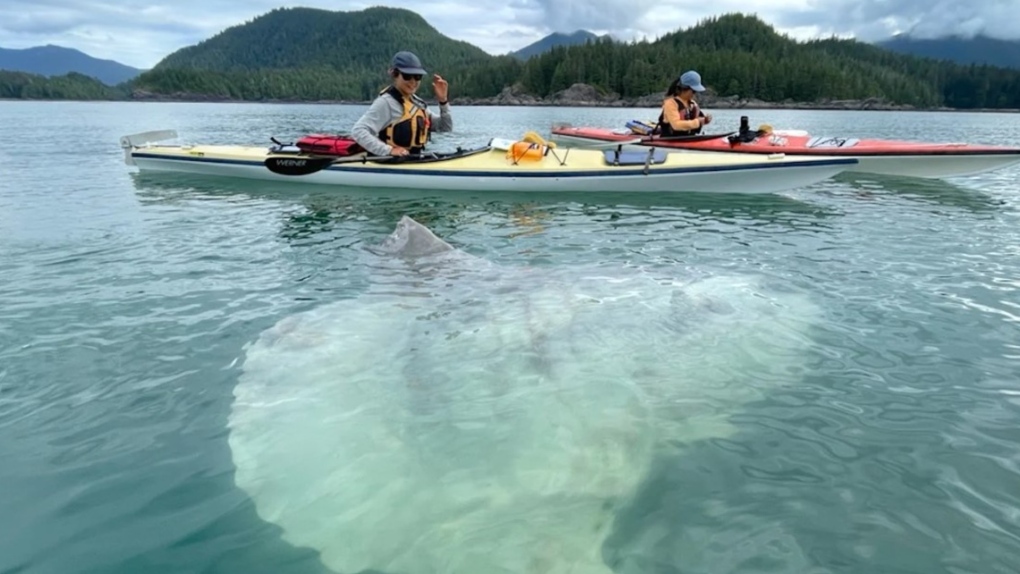Massive ocean sunfish spotted off Vancouver Island
 A massive ocean sunfish, or Mola mola, was sighted in Kyuquot Sound in early August. (Tashi Townley/Marine Education Research Society)
A massive ocean sunfish, or Mola mola, was sighted in Kyuquot Sound in early August. (Tashi Townley/Marine Education Research Society)
Sunfish sightings continue to surface on the West Coast and - Holy Mola! - some examples are pretty big ones.
Jackie Hildering was astonished by a recent photo depicting an enormous Mola mola submitted to the Marine Education Resource Society citizen science project, which is collecting data on two different species of sunfish along the Pacific Coast.
The photo taken in Kyuquot Sound in early August off western Vancouver Island clearly shows the creature's impressive size, said Hildering, noting Molas can be huge, reaching upwards of three metres.
An experienced diver and MERS' education director, Hildering has seen Molas in the past during ocean surveys, but the photo highlights just how magnificent the mysterious fish can be, she said.
“It's such a striking photo. You can see how big it is next to the kayaks,” she said.
The type of Mola in the photo, also known as an ocean sunfish, is one of two species MERS is hoping the public will help collect information on in waters from California to Alaska.
The other Mola species found in West Coast waters is the Mola tecta, also aptly named the hoodwinker sunfish because until recently, it was misidentified as ocean sunfish and so went undetected in waters in the Pacific Northwest, Hildering said.
“They've been hiding in plain sight all this time,” Hildering said.
The existence of the hoodwinker species was confirmed by New Zealand marine scientist Marianne Nyegaard in 2017, noted Hildering.
But it was thought the hoodwinker only frequented the warmer waters of the Southern Hemisphere until Nyegaard discovered social media posts in 2019 with Mola photos from northwest waters misidentifying the specimens as ocean sunfish rather than the newer identified species.
Since then, Nyegaard and other researchers have found other social media posts that show both ocean and hoodwinker sunfish along the West Coast, Hildering said.
MERS is helping collect data on sightings from the public to get a better understanding of the distribution of both types of the Mola fish, she said.
Sightings of Molas are infrequent but not rare and usually take place when the fish is lounging on the surface, an activity that attracts seabirds which will peck off parasites from the marine giants, Hildering said.
The record for the heaviest sunfish weighed to date is 2.3 tonnes, but the giant bony fish are surprisingly agile and fast and can leap from the water when chased by predators, she added.
MERS has collected 23 citizen reports on both kinds of Molas this year, she said.
The recent photo and others submitted by the public demonstrate the value of crowd-sourced science in solving marine mysteries and how much is left to be learned about marine ecosystems, Hildering said.
“The beauty of citizen science is people can help provide pieces to these ocean puzzles.”
To report a Mola sighting to MERS (with photo and/or video) and read about the differences between the two species, see www.mersociety.org/mola.
CTVNews.ca Top Stories

King Charles III focuses Christmas message on healthcare workers in year marked by royal illnesses
King Charles III used his annual Christmas message Wednesday to hail the selflessness of those who have cared for him and the Princess of Wales this year, after both were diagnosed with cancer.
Azerbaijani airliner crashes in Kazakhstan, killing 38 with 29 survivors, officials say
An Azerbaijani airliner with 67 people onboard crashed Wednesday near the Kazakhstani city of Aktau, killing 38 people and leaving 29 survivors, a Kazakh official said.
Montreal man dead after boat explodes in Fort Lauderdale
A Montreal man is dead and several others are injured after a boat exploded in Fort Lauderdale, Florida.
What is Christmas like for Quebec health-care workers who stay on the job?
Most Quebecers get together with family and friends on Christmas Eve, but many professions require people to remain on the job at all times, including health-care workers.
Second storm incoming for Christmas Day in southern B.C.
Environment Canada has issued a new series of weather warnings for British Columbia’s south coast Christmas morning.
Mother-daughter duo pursuing university dreams at the same time
For one University of Windsor student, what is typically a chance to gain independence from her parents has become a chance to spend more time with her biggest cheerleader — her mom.
Trial of man accused in Trump assassination attempt in Florida pushed back to September
A man accused of attempting to assassinate President-elect Donald Trump in South Florida won't be tried until September 2025, a federal judge ruled this week.
Pope urges 'all people of all nations' to silence arms and overcome divisions in Christmas address
Pope Francis in his traditional Christmas message on Wednesday urged 'all people of all nations' to find courage during this Holy Year 'to silence the sounds of arms and overcome divisions' plaguing the world, from the Middle East to Ukraine, Africa to Asia.
Read Trudeau's Christmas message
Prime Minister Justin Trudeau issued his Christmas message on Tuesday. Here is his message in full.






























